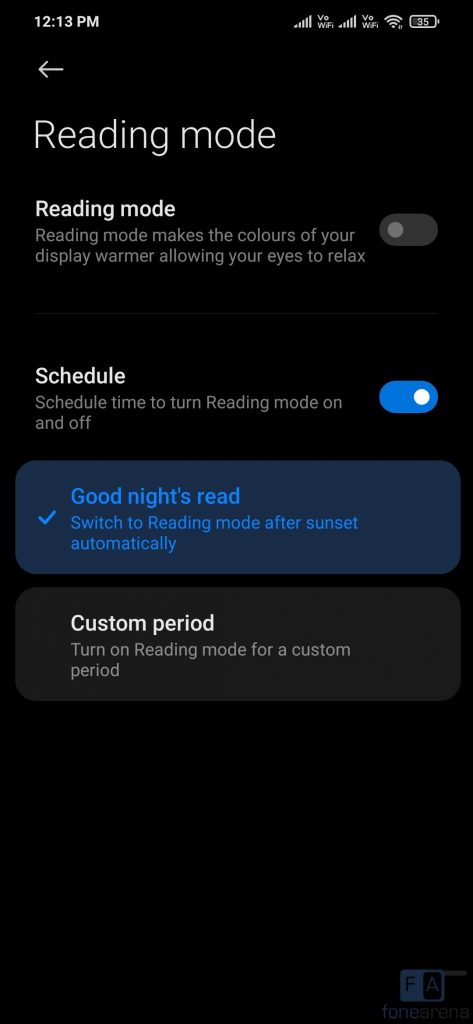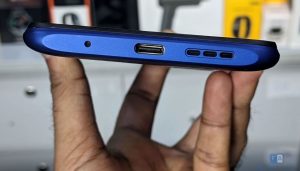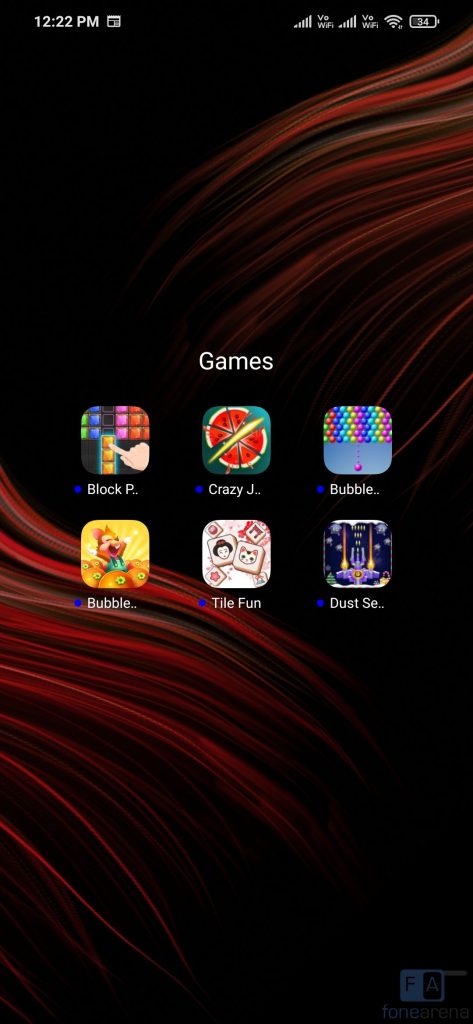
POCO M3 is the latest smartphone from POCO and the successor of last year’s POCO M2. Unlike POCO M2 that was powered by Helio G80 SoC, this one is powered by Snapdragon 662 SoC. It also comes with an improved 48MP main camera and a 6000mAh battery. Is the phone worth the price? Let us dive into the review to find out.
| Box Contents |
| Camera |
| Battery Life |
| Conclusion |
Box Contents

- POCO M3 6GB + 64GB storage version in Cool Blue colour
- USB Type-C Cable
- 2-pin 22.5W charger
- SIM ejector tool
- Clear protective case
- User manual

The POCO M3 has a Full HD+ display with a pixel resolution of 2340 × 1080 pixels, 19.5:9 aspect ratio 2.5D curved glass screen with gentle rounded corners. It has a large 6.53-inch screen size and a pixel density of about 394 PPI. The display is bright, thanks to 400 nits brightness and the colors are vibrant. Sunlight legibility is good, since it has a Sunlight display that uses hardware-level technology to adjust the contrast of each pixel in real time, so images are less affected by glare. It doesn’t have an HDR display like the mid-range POCO M2 Pro. Compared to smartphones in the price range that come with an HD+ screen, FHD+ screen is a welcome move. The screen has Corning Gorilla Glass 3 protection.
Since this has a 19.5:9 aspect ratio screen, you can pinch to zoom to fill the screen when you use video apps, but the content is cropped. There is also an option to hide the notch that adds a black bar on the top. Under the display options there are different options to adjust colors and contrast based on your preference. There is also a reading mode that lets you reduce the display’s blue light emission, so it doesn’t cause eye strain when you are reading at night. There is Dark mode with customizations, similar to other phones running MIUI 12.
Above the display there is an earpiece on the top edge, but it doesn’t have a notification LED. The proximity is on the bezel, but it is hardly visible. It also has a gyroscope and a magnetic sensor, otherwise known as a magnetometer. There is also an 8-megapixel camera on the front. There is a small bezel below the display.
Coming to the button placements and ports. The volume rockers and the power button that also comes with a fingerprint scanner are present on the right. It has dual SIM and a microSD card slot on the left arranged in a single tray. The 3.5mm audio jack is present on the top along with the IR sensor and a vent for the speaker. The primary loudspeaker speaker grill, USB Type-C port and the primary microphone are present on the bottom. This doesn’t miss out on the dedicated dual SIM and microSD card slot.
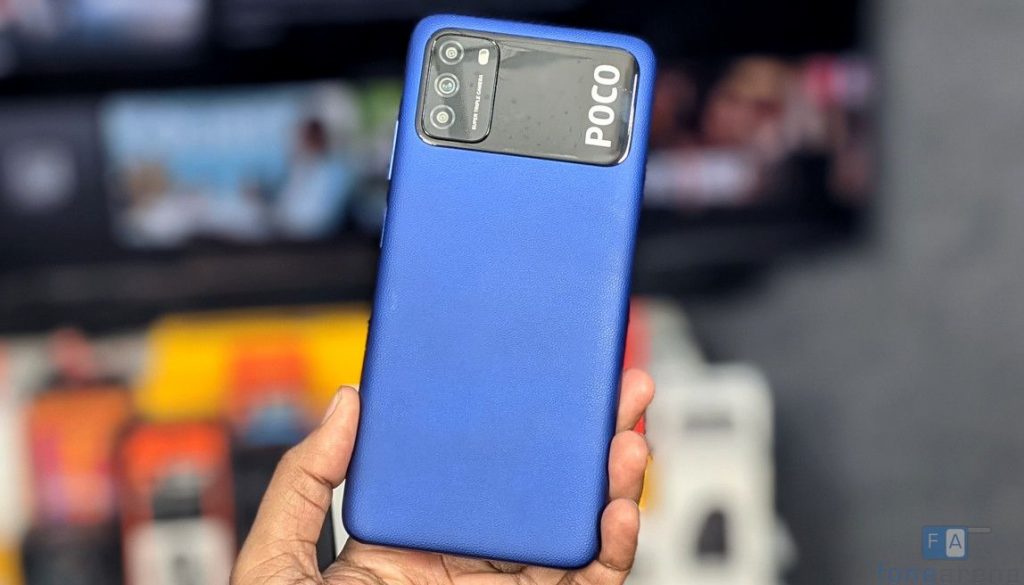
On the back there is a 48-megapixel camera along with a 2-megapixel depth sensor and a 2-megapixel macro camera. This has a slight camera bump due to the large sensor, but the camera lens is protected by a scratch-resistant glass and the case also protects it. Even though the phone has a large screen, it is compact to hold. This has a leather-like finish on the back that offers a good grip and resistance from fingerprints. There is a large POCO branding on top part of the back which is prone to fingerprints easily.

We have the Cool Blue colour, but it also comes in Power Black and POCO Yellow colours. It has Splash proof P2i coating and corrosion-proof ports. The phone weighs 197 grams even though it has a huge 6000mAh battery, and the weight distribution is good. Overall the build quality is good for the price.
Camera
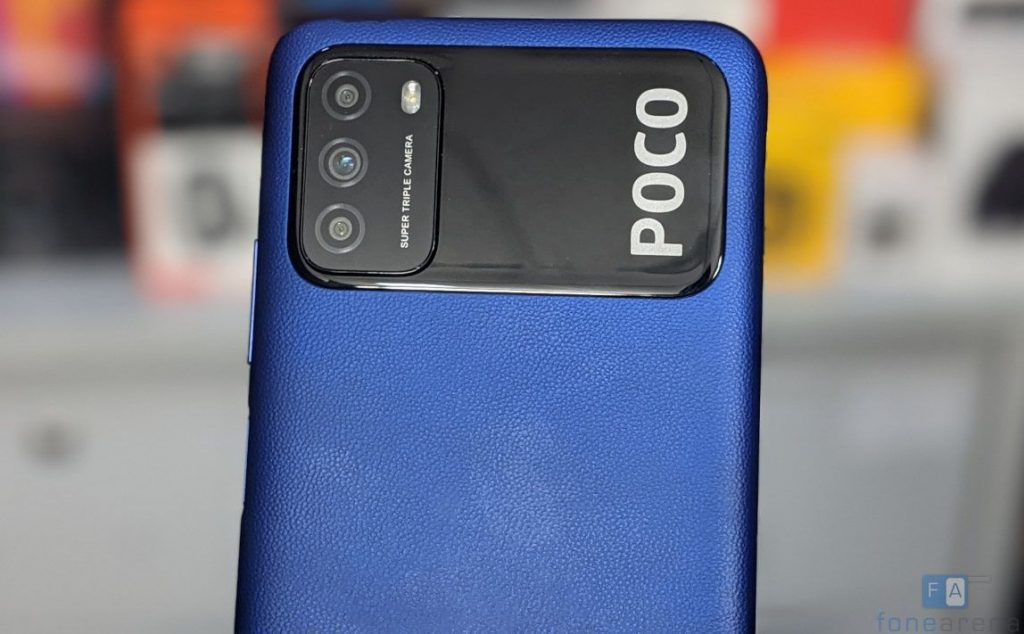
The phone packs triple rear cameras, that includes a main 48-megapixel primary rear camera with single LED Flash, 1/1.2″ Samsung GM1 ISOCELL sensor, 0.8μm pixel size, f/1.79 aperture, 2-megapixel depth sensor with OmniVision OV02B sensor for portrait and a 2-megapixel camera with SK Hynix Hi259 for macro with 1.75μm pixel size and f/2.4 aperture. It has an 8-megapixel front-facing camera with OmniVision OV8856 sensor, 1.12μm pixel size and f/2.05 aperture.
The camera UI is familiar with other Xiaomi smartphones running MIUI 12 with flash, HDR, AI, Filters (Normal, Vivid, Gold Vibes, Lime, Gourmet, Film, Amour, Movie, Soda, Sky blue, Blush, Childhood, Lit, Travel, Rise, Cyberpunk, Black ice, B&W and Classic) and Google Lens on the top. Pressing the menu option shows Movie frame, show gridlines, straighten, Macro, Tilt-Shift, Pro colour and Timed burst. There is a front camera toggle on the bottom along with option to select modes such as Pro, Video, Photo, Portrait, and More option has Night, 48MP, Short Video, Panorama, Documents, Slow motion, Time-lapse and AI watermark. Pro mode lets you adjust white balance, focus, shutter speed (1/4000s to 30 seconds), ISO (100 to 4000). You can also shoot in RAW in Pro mode and enable focus peaking, exposure verification and more options. Beautify option for the front camera lets you adjust several features, in addition to smoothness. The 21:9 wide portrait feature which is called ‘movie frame’ mode works both rear camera front cameras and for video, but there is no separate portrait video mode.

POCO has enabled Cam2API by default, so you can side-load ported Google Camera APKs for advanced editing including RAW capture.
Coming to the image quality, daylight shots came out well, but the white balance is not the best at times since some images look dull even in daylight, but the AI mode helps in such cases. After 4-in-1 pixel binning you get 12MP output. HDR shots are better with improved dynamic range, but the macro shots from the 2MP camera is just average. Portrait shots have good edge detection. 48MP mode that offers a lot of details, but some images can go up to 20MB in size. Even though there is no telephoto lens, it uses the software for offering 2x zoom, which might be handy sometimes, but it doesn’t have much details.
Low-light shots are decent, thanks to 4-in-1 Super Pixel technology that lets the camera’s sensor hardware combine 4 pixels into a single 1.6μm large pixel, and the night mode is even better making the images brighter offering more details, but there is noise and the ISP can’t handle when it comes to low-light shots. Images with flash are good and the flash is not overpowering. Daylight front camera shots are decent for an 8MP camera, but low-light front camera shots are just average. Portrait shots have decent edge detection even though it is done using software.
Check out the camera samples (Click the image to view the full resolution sample.).
It can record videos at 1080p at up to 30 fps, and it also has slow motion 720p resolution video at 120fps. You can also shoot 720p 30 fps video using macro camera. Check out the video sample below.
Software, UI and Apps
It runs Android 10 out of the box with MIUI 12 on top. It was launched running Android security update for November 2020, but it recently got the securiry patch for December 2020. The phone should get Android 11 update in the coming months. MIUI 12 that was introduced last year brings several features including improved animation, Dark mode 2.0, Privacy improvements and more. This has all the usual set of features such as Dual Apps, Second Space, App Lock, Quick Ball and more. Inside the special features option there is Game Turbo, Video toolbox, floating window and Second Space, but misses out Quick Replies and Lite mode that is present in the POCO M2 Pro.
Apart from the usual set of utility apps, Google apps and POCO’s own set of apps, it comes pre-loaded with Amazon, Facebook, WPS Office and LinkedIn app and some games. It also asks for additional app installation during setup, which you can skip. You can easily uninstall these apps, but these come up when you reset the phone. Xiaomi is infamous for showing ads on its phones with MIUI. Even though there is personalized ads option during set up and recommendations in all the apps, you don’t get any ads in apps, similar to the other POCO, Redmi K20 and Mi series phones.
Since the phone has an infrared sensor for remote function, it comes with Mi Remote that lets you control your home appliances easily. It worked flawlessly with Airtel set-top box, Mi TV, AC and other appliances. It also supports A/V receiver, DVD Player, Projector, Camera and more. Out of 6GB RAM, you get 5.7GB of usable RAM, and about 2.4GB of RAM is free when default apps are running in the background. Out of 64GB internal storage, you get about 47GB of free storage. Since this has UFS 2.1 storage, we got sequential read speeds of about 509MB/s. Since the 128GB storage version has UFS 2.2 storage, it will have faster read speeds.
Fingerprint sensor and Face unlock
The phone has a fingerprint sensor on the ride side, embedded into the power button. It immediately unlocks the phone just by keeping your finger on the power button so that you don’t have to press it. This is more convenient compared to the rear-mounted fingerprint scanner and faster than the in-display fingerprint scanner. You can add up to 5 fingerprints. You can also use the fingerprint for app local and payments in apps. The phone also supports face unlock, but it is not as secure as fingerprint since it can be unlocked with a photo.
Music Player, FM Radio and Multimedia
The Mi Music Player is the default music player with usual Xiaomi audio effects and equalizer. It also has FM Radio with recording. Audio through the speaker is loud. Since the phone has stereo speakers audio is louder than the mono speakers found in most smartphones in the price range, which is a good move. Audio through earphones is good as well.
This comes with Widevine L1 support out of the box so that you can enjoy HD content on Amazon Prime Video, Netflix, Hotstar and other streaming apps. This is rarely seen in phones in the price range.
Dual SIM and Connectivity
It supports 4G VoLTE for Reliance Jio, Airtel and other networks and support Dual 4G VoLTE that offers 4G in both the SIM cards at a time. There is Snapdragon X11 LTE modem, but you can’t expect carrier aggregation in the price range. Other connectivity options include Dual-Band Wi-Fi 802.11 ac (2.4 + 5GHz), Wi-Fi calling / VoWiFi support, Bluetooth 5.0 LE and GPS. It also has USB OTG support that lets you connect USB drives. Moving on, the call quality is good, and we did not face any call drops and the earpiece volume was loud. It has stock dialer and messaging apps.

The POCO M3’s body SAR is 0.865 W/Kg (Distance:15mm) and head SAR is at 0.868W/Kg which is below 1W/kg, even though the limit in India is 1.6 W/kg (over 1 g).
Performance and Benchmarks

Coming to the performance, this is powered by an Octa-Core Snapdragon 662 11nm Mobile Platform, which has 4 x Kryo 260 Performance CPUs (A73-based) clocked at up to 2GHz and 4x Kryo 260 Efficiency CPUs (A53-based) at up to 1.8GHz. It has Adreno 610 GPU with support for Open GL ES 3.2, Open CL 2.0, as well as Vulkan 1.1 graphics and 4GB LPDDR4x RAM.
We did not face any issues or frame drops in games. It gets a bit warm on intensive gaming and 4G data use, but it doesn’t get too hot to handle. That said, check out some synthetic benchmark scores below, which shows good performance compared to other mid-range chips, but it can’t beat the Helio G80 when it comes to gaming.

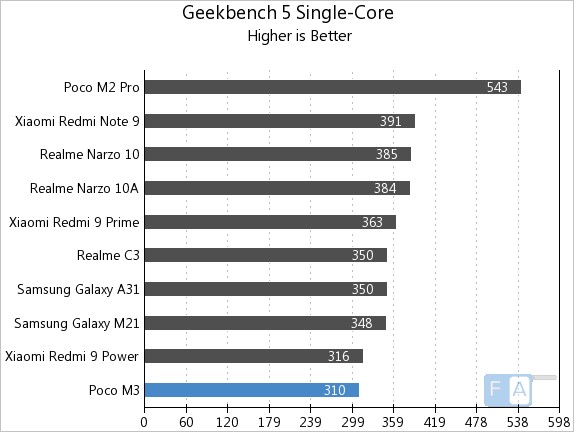

Battery life
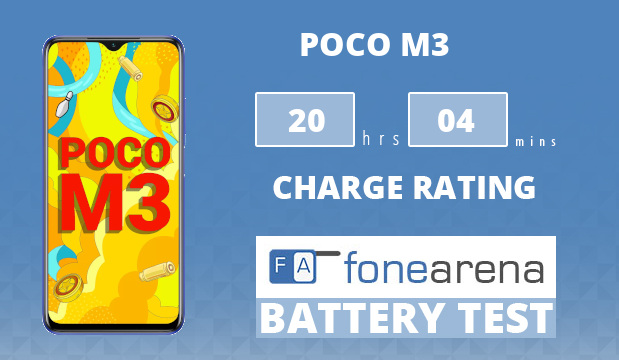
Coming to the battery life, the phone has a 6000mAh (typical) built-in battery. It lasts for a whole day even with heavy use, and with average use it lasts for two days, thanks to optimization in the MIUI 12. Since the phone has support for 18W fast charging, it takes about 1 hour for 0 to 50% and 0 to 100% takes over 2 hours using the bundled fast charger. This is decent for a phone in the price range. If you want faster charging, the POCO M2 Pro is an option, which comes with 33W fast charging at slightly higher cost.
It achieved One Charge Rating of 20 hours and 4 minutes in our battery test, which is almost same as the Redmi 9 Power. Battery life is based on different factors such as software optimization and the processing power that requires to power the phone, so if the phone lasts for a day with heavy use, it is good.
Conclusion
At a starting price of Rs. 10,999, the POCO M3 is decent budget smartphone that comes with a large 6.53-inch FHD+ screen, 6GB of RAM and a 6000mAh battery, compared to most phones in the price range only offer HD+ screen and 4GB of RAM. The build quality is good, 6000mAh battery offers a good battery life and the camera is decent, but it is not impressive.
Competition
The Moto G9 offers a better camera quality and a stock Android experience for the same price, but has a HD+ screen. The latest Redmi 9 Power at the same price is also a good option, if you need an ultra-wide camera but can compromise on 4GB of RAM. If you spend more the POCO M2 Pro is a good deal after the price cut since it doesn’t have ads, puch-hole HDR display and faster 33W charging.
Availability
Priced at Rs. 10,999 for the 6GB RAM with 64GB storage version and Rs. 11,999 for the 6GB RAM with 128GB storage version, it is available from Flipkart. The Yellow version will be available for the first time on 19th of February.
Pros
- Large Full HD+ display
- Smooth performance
- Stereo speakers
- Good battery life
Cons
- Average camera performance
- Ultra-wide camera from POCO M2 is missing



